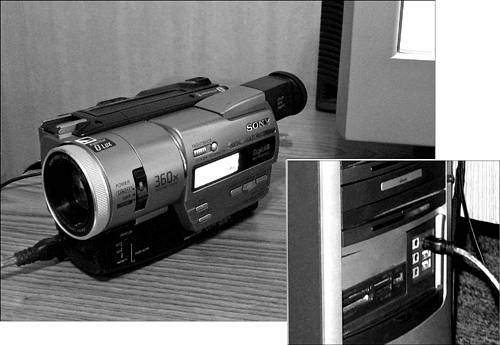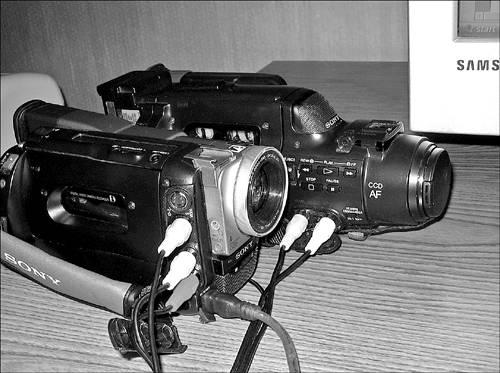Section 4. About Video Capture
4. About Video CaptureThe word capture is the universally used, if not always entirely accurate, term used to describe the process by which video in your camera becomes editable video files on your computer.
Capture The process by which video is transferred from a camcorder to a computer-based editing program and, if necessary, digitized in the process. The physical mechanics of capturing video from your camcorder to your computer is similar, no matter what type of capture you're doing. It always involves streaming your video from your camcorder, down a cable or other connection, into your computer using some sort of capture software. But what type of camcorder, what type of cable connection, and even what types of computer files you ultimately end up with can vary tremendously. Before you can begin editing your video with Premiere Elements, you need to get it into your computer.
To understand why different methodsand different types of hardwareare used in different situations, you need to first understand the difference between analog and digital video. The word analog pretty much describes the world as it existed in the days before computers. The hands on clocks moved by way of a system of mechanical connections and kept time through the interactions of the gears, springs, and other internal machinery. (Sundials, likewise, used one type of movementthe Earth's rotationto measure another movementthat of time.) Music was recorded by etching pulses into some surface as the sounds physically vibrated a stylus. And camcorders recorded light and sound as electronic impulses on magnetic tape.
Analog Literally meaning a representation of something else, the word analog is used, for our purposes, to mean the recording of sound or images with traditional, non-computer-based means, such as a vinyl record album or a VHS videotape. The digital revolution changed all that. Rather than sound or light being recorded as electronic pulses, computer-based transducers interpret thousands or hundreds of thousands of samplings of sound or light every second, recording them not mechanically but as digital codeas 1s and 0sthat reproduce the images and sounds as perfectly and as precisely as they were recorded, time after time and copy after copy.
Digital The recording and processing of any information, including picture and sound, using mathematical measurement, as the way computers use chains of 1s and 0s to represent all data. If analog is like a classic pocket watch, digital is like a precise chronometer, accurate to within microseconds, unfettered by the limitations of traditional mechanics. Right on the nose all the time, every time. For those of us who love to edit video, there is another advantage to the advent of digital recording. Digital video (DV) camcorders and computers speak the same language. They both record and interpret data saved as 1s and 0s. When we bring our digital video into our computers for manipulation and editing, there's virtually no need to translate anything between them. What one puts out the other takes in, and vice versa. For those using analog camcorders, computer-based video editing poses a bit more of a challenge, although not an insurmountable one. This is because, unlike digital video camcorders, analog camcorders record video with more "mechanical" methods. (Think of the difference between music recorded on an analog cassette tape and music recorded on a digital compact disc.) To translate analog video into something that your computer can work with, the analog video must be digitized, or converted into computer code. (See 8 Capture Analog Video.)
Digitizing The process of converting analog information or video into computer files or digital information. Digital video, on the other hand, includes systems introduced to consumers within the past 10 years or so, including the two formats favored by most PC-based video editors: MiniDV and Digital8.
Although their media is slightly different, MiniDV and Digital8 camcorders record identical types of digital data files. In fact, when you're capturing them, your computer can't tell the difference. For consumer and prosumer editors who use programs such as Premiere Elements and Premiere Pro, the preferred method of transferring digital video into a computer is through an IEEE-1394 connection, commonly referred to as FireWire. In fact, when transferring files from MiniDV and Digital8 camcorders over FireWire, the word capture doesn't accurately apply. The data recorded by MiniDV and Digital8 camcorders remains unchanged as it passes over a FireWire connection, only the "envelope" the data travels in changes as clips of video data are saved in the computer as DV-AVIs. (See 5 Capture Digital Video Using FireWire.) DV-AVIs are the preferred workflow for PC-based editing. They are by far the most efficient, trouble-free files you can use in Premiere Elements. Use them whenever possible, and you increase the odds of having a problem-free project.
Not all AVIs are created equal! The DV in DV-AVI refers to the codec or compression-decompression method used to squeeze the data into the file. The DV codec is favored by PC-based video editors because it is nearly lossless. But an AVI (a PC-based media format which stands for Audio Video Interweave) could be using any one of the dozens of codecs available, however, and unless you have that codec installed on your computer, these files will not play well with Premiere Elements. In addition to those camcorders that connect to your computer using FireWire, a newer class of digital camcorders has recently come on the scene. These camcorders connect to computers through the recently developed USB Video Class 1.0. These DV camcorders, however, should not be confused with DVD camcorders or MicroMV camcorders that connect to a computer using a traditional USB 1.0 cable. Because of the way DVD and MicroMV camcorders store their data (usually as MPEGs) and that they stream this video data at a much lower rate, their video files are captured with the Media Downloader rather than in Premiere Elements's standard Capture workspace. (For more information, see 14 Add Media with the Adobe Media Downloader.)
As an alternative to using the Media Downloader, video files from MicroMV and DVD camcorders can be captured with the same methods used to capture analog video. (See 8 Capture Analog Video.) USB Video Class 1.0 is an extremely fast delivery system for streaming video data over a standard USB 2.0 connection, in some ways even superior to FireWire. And, while this system is new and still relatively rare, Premiere Elements 2.0 is capable of connecting to these camcorders and capturing the files with a method not unlike that used for traditional FireWire capture. (See 6 Capture Digital Video Using USB.)
Although DVD camcorders and MicroMV camcorders offer tremendous advantages in size and conveniences, these camcorders store their video files as MPEGs and offer no direct method for capturing these files as DV-AVIs. The best methods for transferring their video into Premiere Elements is either by means of the Media Downloader (See 14 Add Media with the Adobe Media Downloader) or by connecting them to the computer through a DV bridge system capable of capturing video as DV-AVIs (see 8 Capture Analog Video). One method for capturing analog video is to use a passthrough, attaching your analog camcorder to your computer through a DV camcorder.
Although transfer might be a better term to describe the way DV is brought into a computer, capture is a fairly accurate term for the way analog video is brought into a computer. Because analog camcorders and digital computers store their video files as very different formats, some type of device is required to capture them, or convert these analog pulses into digital code, in order to transfer them into a computer. (See 8 Capture Analog Video). Capturing any video to your computer is a processor-intensive activity. Current systems and computers sold in the past few years seem to be able to handle it effortlessly, but users of older computers can find it somewhat challenging. Regardless of how powerful your system is, some basic computer maintenance can always work to your benefit:
|
EAN: 2147483647
Pages: 199
 KEY TERM
KEY TERM
